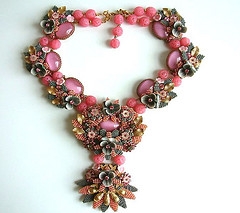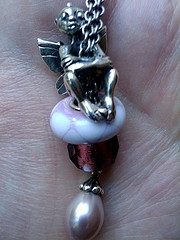
Tiffany glass
Types of Tiffany glass
Opalescent glass
The term opalescent glass is commonly used to describe glass where more than one color is present, being fused during the manufacture, as against flashed glass in which two colors may be laminated, or silver stained glass where a solution of silver nitrate is superficially applied, turning red glass to orange and blue glass to green. Some opalescent glass was used by several stained glass studios in England from the 1860s and 1870s onwards, notably Heaton, Butler and Bayne. Its use became increasingly common. Opalescent glass is the basis for the range of glasses created by Tiffany.
Favrile glass
Tiffany patented Favrile glass in 1880. The trade name Favrile was derived from the French word, fabrile, meaning handcrafted.
Favrile glass often has a distinctive characteristic that is common in some glass from Classical antiquity: it possesses a superficial iridescence. This iridescence causes the surface to shimmer, but also causes a degree of opacity. This iridescent effect of the glass was obtained by mixing different colors of glass together while hot.
According to Tiffany:
“Favrile glass is distinguished by brilliant or deeply toned colors, usually iridescent like the wings of certain American butterflies, the necks of pigeons and peacocks, the wing covers of various beetles.”
Streamer glass
Streamer glass
Fracture glass
Fracture-streamer glass
Herringbone ripple glass
Ring mottle glass
Drapery glass incorporated in a reproduction of Tiffany’s “Magnolia” lampshade
Streamer glass refers to a sheet of glass with a pattern of glass strings affixed to its surface. Tiffany made use of such textured glass to represent, for example, twigs, branches and grass.
Streamers are prepared from very hot molten glass, gathered at the end of a punty (pontil) that is rapidly swung back and forth and stretched into long, thin strings that rapidly cool and harden. These hand-stretched streamers are pressed on the molten surface of sheet glass during the rolling process, and become permanently fused.
Fracture glass
Fracture glass refers to a sheet of glass with a pattern of irregularly shaped, thin glass wafers affixed to its surface. Tiffany made use of such textured glass to represent, for example, foliage seen from a distance.
The irregular glass wafers, called fractures, are prepared from very hot, colored molten glass, gathered at the end of a blowpipe. A large bubble is forcefully blown until the walls of the bubble rapidly stretch, cool and harden. The resulting glass bubble has paper-thin walls and is immediately shattered into shards. These hand blown shards are pressed on the surface of the molten glass sheet during the rolling process, to which they become permanently fused.
Fracture-streamer glass
Fracture-streamer glass refers to a sheet of glass with a pattern of glass strings, and irregularly shaped, thin glass wafers, affixed to its surface. Tiffany made use of such textured glass to represent, for example, twigs, branches and grass, and distant foliage.
The process is as above except that both streamers and fractures are applied to sheet glass during the rolling process.
Ripple glass
Ripple glass refers to a sheet of textured glass with marked surface waves. Tiffany made use of such textured glass to represent, for example, water or leaf veins.
The texture is created during the glass sheet-forming process. A sheet is formed from molten glass with a roller that spins on itself, while travelling forward. Normally the roller spins at the same speed as its own forward motion, and the resulting sheet has a smooth surface. In the manufacture of rippled glass, the roller spins faster than its own forward motion. The rippled effect is retained as the glass cools.
Ring mottle glass
Ring mottle glass refers to sheet glass with a pronounced mottle created by localized, heat-treated opacification and crystal-growth dynamics. Ring mottle glass was invented by Tiffany in the early 20th century. Tiffany’s distinctive style exploited glass containing a variety of motifs such as those found in ring mottle glass, and he relied minimally on painted details.
When Tiffany Studio closed in 1928, the secret formula for making ring mottle glass was forgotten and lost. Ring mottle glass was re-dicscovered in the late sixties by Eric Lovell of Uroboros Glass. Traditionally used for organic details on leaves and other natural elements, ring mottles also find a place in contemporary work when abstract patterns are desired.
Drapery glass
Drapery glass refers to a sheet of heavily folded glass that suggests fabric folds. Tiffany made adundant use of drapery glass in ecclesiastical stained glass windows to add a 3-dimensional effect to flowing robes and angel wings, and to imitate the natural coarseness of magnolia petals.
The making of drapery glass requires skill and experience. A small diameter hand-held roller is manipulated forcefully over a sheet of molten glass to produce heavy ripples, while folding and creasing the entire sheet. The ripples become rigid and permanent as the glass cools. Each sheet produced from this artisanal process is unique.
Techniques for cutting Tiffany glass
In order to cut streamer, fracture or ripple glass, the sheet may be scored on the side without streamers, fractures or ripples with a carbide glass cutter, and broken at the score line with breaker-grozier pliers.
In order to cut drapery glass, the sheet may be placed on styrofoam, scored with a carbide glass cutter, and broken at the score line with breaker-grozier pliers, but a bandsaw or ringsaw are the preferred tools.
Locations and collections
Stained glass in situ
Arlington Street Church, Boston, Massachusetts
Congregation Beth Ahabah, Richmond, Virginia
Macy’s on State Street, formerly Marshall Field’s, Chicago, Illinois
Irvington Presbyterian Church, Irvington, New York
Reading Room, Irvington Town Hall, Irvington, New York
St. Michael’s Church, New York City
Second Presbyterian Church, Indianapolis, Indiana
Temple Emanuel, (Grand Rapids, Michigan)
West End Collegiate Church, West End Avenue, New York
Willard Chapel, Auburn, New York
Museums
Haworth Gallery, Accrington, UK
The Neustadt Collection of Tiffany Glass, Long Island City, NY
See also
Tiffany lamps
Notes
^ Lee, Lawrence; Seddon, George and Stephens, Francis. Stained Glass, 1976, Spring Books ISBN 0-600-56281-6
^ The use of the term opalescent is actually a misnomer. Opalescence actually refers to the quality of changing color under transmitted light, rather than the quality of having several colors present. A rare example of true opalescent glass is the Roman Lycurgus cup in the British Museum
^ http://www.hyndburnbc.gov.uk/hag
^ http://www.neustadtcollection.org
v d e
Glass makers and brands
Contemporary
companies
Anchor Hocking Arc International Ardagh Armashield Asahi Aurora Glass Foundry Baccarat Blenko Glass Company Bodum Corning Dartington Crystal Daum Edinburgh Crystal Fanavid Fenton Art Glass Company Firozabad glass industry Franz Mayer Glava Glaverbel Hardman & Co. Heaton, Butler and Bayne Holmegaard Glassworks Holophane Hoya Kingdom of Crystal Kokomo Opalescent Glass Works Kosta Glasbruk Libbey Owens Ford Liuli Gongfang Iittala Luoyang Johns Manville Mats Jonasson Mlers Moser Glass Mosser Glass Nippon Sheet Glass Ohara Orrefors Glasbruk Osram Owens Corning Owens-Illinois Pauly & C. – Compagnia Venezia Murano Phu Phong PPG Pilkington Preciosa Quinn Group Riedel Royal Leerdam Crystal Saint-Gobain Samsung Corning Precision Glass Schonbek Schott Shrigley and Hunt Steuben Glass Sterlite Optical Technologies Swarovski Tyrone Crystal Val Saint Lambert Verrerie of Brehat Waterford Watts & Co World Kitchen Xinyi Glass Zwiesel
Historic
companies
Bakewell Glass Belmont Glass Company Boston and Sandwich Glass Company Carr Lowrey Glass Company Cambridge Glass Chance Brothers Clayton and Bell Dunbar Glass Fostoria Glass Company General Glass Industries Alexander Gibbs Grnvik glasbruk Hazel-Atlas Heisey Hemingray Glass Company Knox Glass Bottle Company Lavers, Barraud and Westlake Manufacture royale de glaces de miroirs Morris & Co. Old Dominion Glass Company James Powell and Sons Ravenhead glass The Root Glass Company Sneath Glass Company Ward and Hughes Westmoreland Glass Company Whitall Tatum Company White Glass Company Worshipful Company
Glassmakers
John Adams Richard M. Atwater Frederick Carder Irving Wightman Colburn Henry Crimmel Henry Clay Fry Friedrich A. H. Heisey Libbey Antonio Neri Alastair Pilkington Salviati Otto Schott S. Donald Stookey W. E. S. Turner John M. Whitall
Trademarks
and brands
Bohemian glass Bomex Burmese glass Chevron bead Corelle CorningWare Cranberry glass Cristallo Duran Endural Favrile Fire King Gold Ruby MACOR Opaline glass Pyrex Ravenhead glass Tiffany glass Vitrite Vitrolite Vycor Waterford Crystal Wood’s glass Zerodur
Categories: Architectural elements | Glass types | Glass art | Glass trademarks and brands | Stained glass
About the Author
I am a professional editor from
China Suppliers
, and my work is to promote a free online trade platform.
http://www.frbiz.com/ contain a great deal of information about
sirius fm modulator
,
cd changer cartridge
welcome to visit!
Trollbead Silver Python
